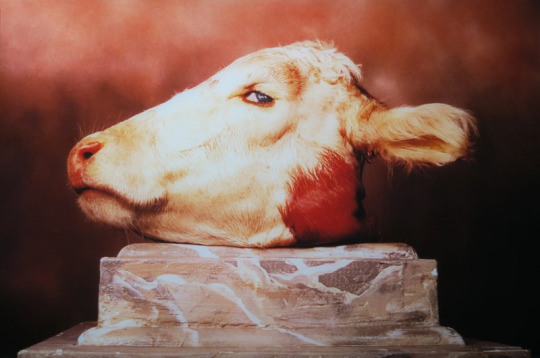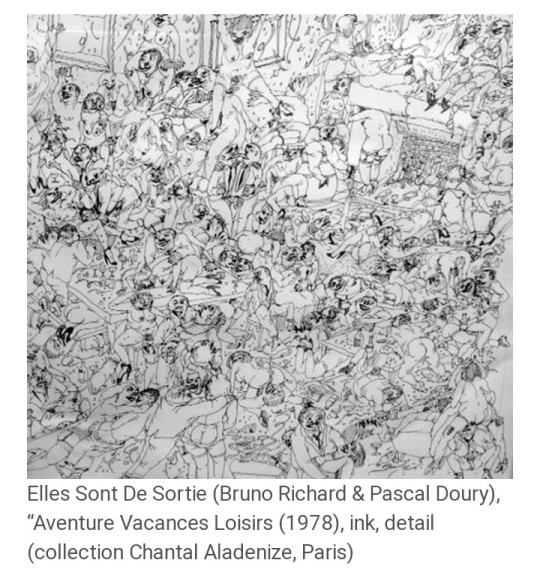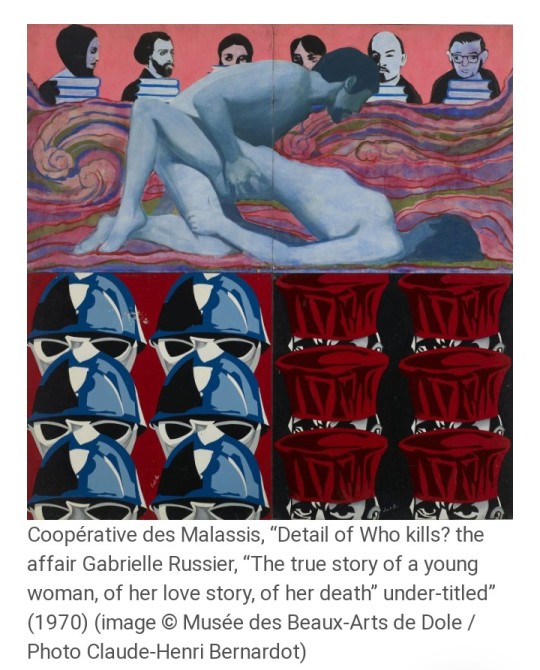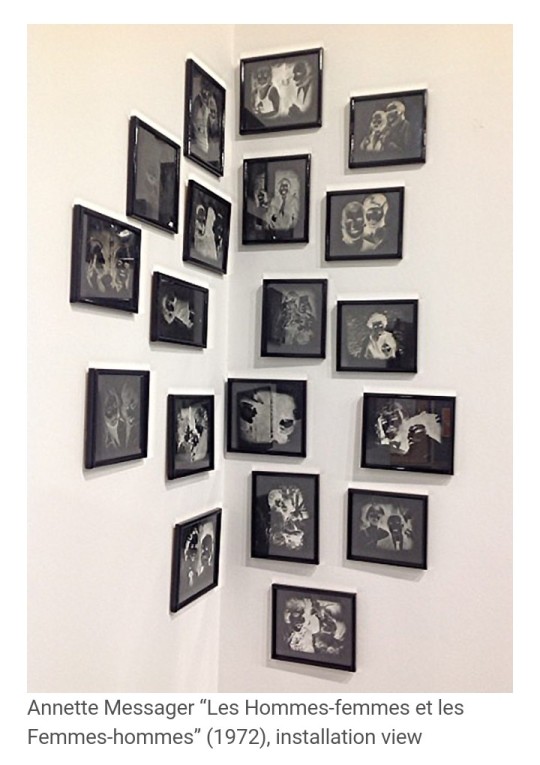#galbert Paris
Photo

02x01 "Voulez-Vou Coucher Avec Moi" - 2021
Galbert Paris Fancy Bomber - Starts at 13,000€
Worn with: Roger Vivier Bag
3 notes
·
View notes
Text

Andres Serrano, Cabeza De Vaca, EarlyWorks. Paris, Collection Antoine de Galbert
Courtesy Alain Truong
113 notes
·
View notes
Text
PARIS, April 2017 — Before filter bubbles, there were countercultures: self-selecting groups that did not give a shit about what other people liked or wanted. [...]
The latest misty-eyed effort is Guillaume Désanges and François Piron’s display of 700 pieces of punk and post-punk art and ephemera, L’Esprit français, Countercultures, 1969–1989, which is jarring the house at Antoine de Galbert’s La Maison Rouge.






Pierre Klossowski, "L'Hermaphrodite souverain", 1972

Bérurier Noir, “Macadam Massacre” (1984), vinyl record cover

Jorge Damonte, “Copi posing for one of his roles in the play Le Frigo” (1983) (image courtesy Lola Mitchell)

#l'esprit français#countercultures 1969-1989#exhibition#mostra#art#punk art#punk#post punk#french punk and post punk#counterculture#subcultures#sottoculture#2017#la maison rouge#le monde
10 notes
·
View notes
Text

“Black tide” (2023), broken laminated glass from vitroplus , black lacquer, nails, wood, medium, silicone, and tape, 3.5 x 10 x 9 meters. Installed in Maison Hazeur for Passages Insolites in Quebec, Canada.
Tons of Broken Glass Flood Architectural Spaces in Captivating Site-Specific Installations by Baptiste Debombourg
All images © Baptiste Debombourg

“(R)evolve” (2017), windshields, wood, nails, screws, and paint, 8 x 8 x 4.5 meters. Installed at Eduardo Secci Gallery in Florence, Italy

“Aerial” (2012), 33/2 laminated glass from Glas König, wood, nails, and white paint, 3 x 12 x 4.5 meters, two ons of glass. Installed at Brauweiler Abbey in Pulheim, Germany

“Acceleration field” (2015), white laminated glass, wooden structure, screws, nails, paint, silicone3D, 11 x 7 x 1.8 meters, 250 meters2 glass at four tons. Installed at Fondation Antoine de Galbert in Paris, France, with technical assistance from Léa Marchalwith the support of Wellmade and Saint-Gobain
#baptiste debombourg#artist#art#broken laminated glass from vitroplus#black lacquer#nails#wood#medium#silicone#tape#site-specific art installations#architectural spaces#paint#large-scale art installations#laminated glass from glas konig
3 notes
·
View notes
Photo

Wednesdays at A’s, 330 Broome St. NY 1979-1981
French edition • Anamosa, Paris, with the support of Fondation Antoine de Galbert
2021 • 172 × 220 mm • 192 pages • ISBN: 978-2-38191-037-6
2 notes
·
View notes
Photo

installation view “Berlinde de Bruyckere. Een”, La Maison Rouge, Fondation Antoine de Galbert, Paris, France, 2005
#installation#berlinde de bruyckere#horse#art#sculpture#soft sculpture#flesh#i also left a skin there#female artists#belgian art#contemporary art
37 notes
·
View notes
Photo

“We appreciate gifts, but free, unconditional, and without ulterior motives.” So says a group of 24 French artists, museum workers, politicians, and others who published an open letter in Libération yesterday rejecting the monumental “Bouquet of Tulips” sculpture that Jeff Koons offered to the city of Paris in 2016. The signatories include former Minster of Culture and Communication Frédéric Mitterrand, artists Christian Boltanski, Jean-Luc Moulène, and Tania Mouraud, filmmaker Olivier Assayas, collectors Marin Karmitz and Antoine de Galbert, and curator Nicolas Bourriaud, among others. They describe the project to install the Koons sculpture in the plaza between Paris’s Palais de Tokyo and the Museum of Modern Art of the City of Paris as shocking and call the work itself and the choice of site “at the very least surprising, if not opportunistic, perhaps even cynical.”
Non, Merci! French Artists and Cultural Workers Reject Giant Jeff Koons Sculpture
27 notes
·
View notes
Photo

ŒUVRE PROPOSÉE À LA VENTE DANS LE CADRE D’UNE INITIATIVE POUR AIDER LES ARTISTES. #lesamisdesartistes « Radiographie d’une chimère » 21 x 30 cm, encre et aquarelle sur papier, 300 € frais de port inclus. L’acheteur verse 70 % du prix (210 €) directement à l’artiste et les 30 % restants (90 €) à une cagnotte solidaire Leetchi au profit d’une association assurant leur distribution auprès d’autres artistes. Pour la première opération, dès que la cagnotte aura atteint 4000 €, elle sera intégralement reversée au fond de soutien de la fondation Antoine de Galbert qui en fera don au collectif d’artistes qu’elle souhaite soutenir. Par la suite, d’autres associations prendront le relais Pour plus d’informations lesamisdesartistes.com @lesamisdesartistes @isabelledemaisonrouge #art #artsolidaire #artwork #artparis #aquarelle #watercolor #painting #papier #paper #veroniquedurruty #rawart #artnaif #outsiderart #outsiderartist #naiveart #naiveartist #artbrut #artcollection #artcollector #artcurator #artcontemporain #contemporaryart #contemporarydrawing #lesamisdesartistespeinture #mythe #centaure #dessin #dessincontemporain #lesamisdesartistesdessin (à Paris, France) https://www.instagram.com/p/B_lTcM9poQN/?igshid=weh1cf9w58g8
#lesamisdesartistes#art#artsolidaire#artwork#artparis#aquarelle#watercolor#painting#papier#paper#veroniquedurruty#rawart#artnaif#outsiderart#outsiderartist#naiveart#naiveartist#artbrut#artcollection#artcollector#artcurator#artcontemporain#contemporaryart#contemporarydrawing#lesamisdesartistespeinture#mythe#centaure#dessin#dessincontemporain#lesamisdesartistesdessin
0 notes
Text
The Survivor of Auschwitz Who Painted a Forgotten Genocide
Philosophers said the Holocaust defied representation, that art could not render its horrors. But Ceija Stojka made more than 1,000 incredible images of her ordeal, and the effort to exterminate the Roma.
Image
Ceija Stojka, “Auschwitz 1944,” 2009. Her paintings of Auschwitz burn with a rage and shame not dulled by three-quarters of a century.
Ceija Stojka, “Auschwitz 1944,” 2009. Her paintings of Auschwitz burn with a rage and shame not dulled by three-quarters of a century.Credit...Ceija Stojka/Artist Rights Society (ARS), New York; Collection of Antoine de Galbert, Paris
By Jason Farago
Jan. 27, 2020
MADRID — At first the soldiers of the Red Army found almost nothing when they reached the camp in the southwest of occupied Poland that January. The retreating Nazis had blown up its crematories, dismantled its gas chambers; the prisoners had been marched west, in the freezing cold. Only later, as the Soviets liberated Auschwitz 75 years ago Monday, did they discover the last, straggling survivors, too ill or young to leave the inferno where at least 1.1 million people were murdered, 90 percent of them Jews.
Immediately after the war, writers and philosophers maintained that the death camps defied representation; no art could ever do justice to their horrors, and even the concept of poetry after Auschwitz, in Theodor W. Adorno’s notorious phrase, had become “barbaric.” Yet survivors themselves, as early as Primo Levi’s 1947 memoir, “If This Is a Man,” have forced themselves to make sense of the horrors they endured in art — and as Auschwitz recedes into historical distance and the last survivors disappear, there are voices even the greatest skeptic of representation cannot afford to tune out.
One is the self-taught Austrian artist Ceija Stojka (1933-2013), a member of the Roma minority (sometimes derogatorily called “Gypsies”), who turned the ordeals of the camps into an art of immense power. At 10, she was deported to Auschwitz, the first of three camps she would outlast. She slept on the pathway to the gas chambers, and hid among heaps of corpses; she survived by eating tree sap.
Image
Ceija Stojka, photographed in 1995. She arrived at Auschwitz in March 1943, as a girl, and was assigned to filthy barracks reserved for Roma prisoners. The Z in her tattoo, stood for Zigeuner, “Gypsy.”
Ceija Stojka, photographed in 1995. She arrived at Auschwitz in March 1943, as a girl, and was assigned to filthy barracks reserved for Roma prisoners. The Z in her tattoo, stood for Zigeuner, “Gypsy.”Credit...Christa Schnepf
For more than 40 years after the liberation she kept quiet about what she had withstood. Then it flooded out: scenes of rhapsodic childhood and unspeakable torture, painted with runny pigment and in brazen colors, impassioned, unashamed, irrefutable.
She made more than 1,000 such paintings and drawings between 1990 and her death in 2013, and I saw more than 100 of them recently at the Museo Reina Sofía, in Madrid. I had seen a few of her paintings in isolation at an art fair in New York last year (the first time her work had been shown in the United States) but I was not prepared for the full intensity of her art of barracks and cattle cars, ravens and sunflowers, sadistic kapos and emaciated prisoners. Not only a testimony to an occluded genocide, Stojka’s art also stood up for the possibility — even the necessity — for human creativity to represent, and take ownership of, the darkest chapters of history.
Stojka (her name is pronounced CHAY-ya STOY-ka) was one of six children born into a family of nomadic horse-traders. The family spoke both Romani and German. After the Nazis annexed Austria, they gave up their itinerant life and settled in Vienna.
A prologue to the Reina Sofía exhibition includes some of the “light paintings” Stojka made of her childhood. We see women in kerchiefs and long dresses as the sun sets beside their caravans. Sunflowers blossom like fireworks. Willows pullulate with blotchy foliage that recalls her fellow Austrian Gustav Klimt.
Image
Ceija Stojka, “Untitled,” 1995. Her art stood up for the possibility — even the necessity — for human creativity to represent, and take ownership of, the darkest chapters of history.
Ceija Stojka, “Untitled,” 1995. Her art stood up for the possibility — even the necessity — for human creativity to represent, and take ownership of, the darkest chapters of history.Credit...Ceija Stojka/Artist Rights Society (ARS), New York; Collection of Nuna & Hojda Stojka; Ceija Stojka International Fund, Vienna
In 1941, her father was deported to Dachau; he would later be murdered at what was euphemistically called a “euthanasia center.” The next year, Heinrich Himmler issued a decree that “all Gypsy mixed-bloods” were to be deported to Auschwitz, and treated “on the same level as Jews.” (That decree contradicts the falsehood, widely espoused after World War II, that the Roma were “antisocial” and not specifically targeted for extermination. The Roma genocide was not raised at the Nuremberg trials; West Germany recognized the persecution as a racist act only in 1982.)
Stojka would paint the cattle car in which she was deported: a rickety thing, its rear window barred, charging into a sky burning white, pink and orange. She arrived at Auschwitz in March 1943, and was assigned to filthy barracks reserved for Roma prisoners. The girl’s arm was tattooed, with the number Z-6399. The Z stood for Zigeuner, “Gypsy.”
She painted that too, in one of her sparest and most modern pictures: a red hand and forearm lost in a sea of black, interrupted by a shaft of white suggesting an absent god. In old age Stojka would treat her tattoo almost as an insignia; a photomural at the Reina Sofía shows her smiling for a portrait, cigarette between her fingers, her decades-old number proudly visible.
Image
Ceija Stojka, “Untitled/Vienna - Auschwitz.”
Ceija Stojka, “Untitled/Vienna - Auschwitz.”Credit...Ceija Stojka/Artist Rights Society (ARS), New York; Collection of Nuna & Hojda Stojka. Ceija Stojka International Fund, Vienna.
Her paintings of Auschwitz, where she was interned for a little more than a year, burn with a rage and shame not dulled by three-quarters of a century. Prisoners, presumably fellow Roma to judge from their kerchiefs, peer from their barracks as the kapos wield their bullwhips, while wraithlike captives walk single-file past a cart full of corpses. Nude women, arms thrust to the sky, march at gunpoint into the lethal showers. The sky rots into an otherworldly purple interrupted by the white smoke of the crematorium. Birds recur as gashed Vs, barbed wire as rows of Xs. And bodies: faceless, reduced in places to a few strokes of black.
Image
Ceija Stojka, “Los, Los, weitergehen! Damals 1943-1944. Auschwitz ist kein(e) Lüge. (Move, move, keep moving! In the years 1943–44. Auschwitz is not a lie),” 2006.
Ceija Stojka, “Los, Los, weitergehen! Damals 1943-1944. Auschwitz ist kein(e) Lüge. (Move, move, keep moving! In the years 1943–44. Auschwitz is not a lie),” 2006.Credit...Ceija Stojka/Artist Rights Society (ARS), New York; Collection of Nuna & Hojda Stojka. Ceija Stojka International Fund, Vienna.
Many of these paintings are done on cardboard; she sometimes used her fingers to score the paint, which gets Van Gogh-thick in places, fluid and emulsified in others. They have a detachment and unsentimentality that recalls the fiction of Imre Kertesz, the Nobel-winning novelist and fellow Auschwitz survivor. Though Stojka used painting to give form to trauma, these works do not express private grief so much as they bear public witness. One painting, which gives the Reina Sofía show its title, states its testimonial character as bluntly as possible: “This Has Happened.”
For compared to the Holocaust of European Jewry, the Roma extermination has been less studied and less commemorated. What in Hebrew is called the Shoah (“calamity”) is, in the Romani language, known as the Porajmos: the “devouring.” No authoritative death toll has ever been established; estimates range from 250,000 to 500,000 people, or up to half the Roma population of Europe. Their persecution went on after World War II, and still does. In 2018 Matteo Salvini, the leader of Italy’s far-right League party, proposed a census of the Roma population as part of a “mass cleansing.”
In 1944, Stojka and her family were transferred to Ravensbrück — only weeks before all the remaining Roma prisoners of Auschwitz were gassed on a single night. She was moved again, to Bergen-Belsen, at the start of 1945. In Stojka’s paintings of this final camp, the coldblooded order of Auschwitz has given way to chaotic, even apocalyptic desolation. Fires rage before acres of black earth, and skeletons lie tangled in darkness; a single prisoner, stranded in the snow, looks goggle-eyed at a pair of blackbirds on a barbed-wire fence.
Image
Ceija Stojka, “Bergen-Belsen 1945,” 1996.
Ceija Stojka, “Bergen-Belsen 1945,” 1996.Credit...Ceija Stojka/Artist Rights Society (ARS), New York; Galerie GP & N Vallois, Galerie Christophe Gaillard, Paris.
The British liberated Bergen-Belsen that April. Ceija and her mother walked across Germany and Czechoslovakia to Vienna. She resumed an itinerant life at first, then spent decades as a carpet seller — and only in 1988, encouraged by the documentary filmmaker Karin Berger, did she begin to speak of what she survived and to teach herself how to paint. Her writing and art made her a public figure in Austria, as well as an advocate for Roma across Europe.
This will be the last major anniversary of the liberation of Auschwitz with a significant number of survivors. And the further we get from Auschwitz, the easier it is to reduce its horrors to kitsch or light entertainment. (Consider the self-satisfied, Nazis-are-people-too “Jojo Rabbit,” garlanded with a best picture Oscar nomination.) There is so much bad art out there, in our libraries and streaming services, that you can ask yourself whether Adorno was right all along: better to just stay silent.
Yet the better question, 75 years on, is not whether one can represent Auschwitz. The question is: for what purposes would one want to make a new image of the worst place on earth?
Rare are the artists who can answer that question convincingly. Stojka was one of them, establishing a living archive for those not yet born. You don’t paint for yourself; you paint for the world you want to see, to silence the blind nationalists and denialists who have been given a new lease on life. “How can they say, ‘There was no Auschwitz’?” she once retorted. “I have it right on my arm.”
0 notes
Photo

02x01 "Voulez-Vou Coucher Avec Moi" - 2021
Roger Vivier Embellished Leather Shoulder Bag - $1395.00
Worn with: Galbert Paris Jacket
1 note
·
View note
Photo

The other Night in Paris #alpine #renaultalpine #alpine110 #sportscar #design #madeinfrance #style #paris #photography #rampstyle #driveinstyle #lovethiscar #automotive #automotivephotography #cool (at La Maison rouge, fondation Antoine-de-Galbert) https://www.instagram.com/p/B2lHXtrIakf/?igshid=1mbl8rtxkpjor
#alpine#renaultalpine#alpine110#sportscar#design#madeinfrance#style#paris#photography#rampstyle#driveinstyle#lovethiscar#automotive#automotivephotography#cool
0 notes
Photo

This is not here - La Maison rouge fondation Antoine-de-Galbert, Paris - dimanche 28 mai 2017
“This is not here” - unlimited series - une empreinte originale est placée in situ - éditions assez, carte postale (15x10cm)
www.aldocaredda.com
1 note
·
View note
Text
Un monde en tête - la donation Antoine de Galbert: Lyon (F) bis 15.03.2020
Un monde en tête – la donation Antoine de Galbert: Lyon (F) bis 15.03.2020
Die Menschheit bedeckt ihren Kopf. Erstaunlich, manchmal spektakulär, schützt der Kopfschmuck ihn vor Sonne oder schlechtem Wetter. Es gibt dem Träger auch einen sehr symbolischen Schutz. Kopfbedeckungen, Federkappen und Kronen können Sinnbilder für Macht oder Identität sein. In vielen Gesellschaften prägen sie den Status des Individuums: Bräutigam, Tänzer, Schamane, Krieger oder Monarch …
Antoin…
View On WordPress
#Amazonasfedern#Antoine de Galbert#Ethnologie#Federkappe#Hochzeitskopfschmuck#Hut#Inspiration#Kopfbedeckungen#Kopfschmuck#Krone#La MAison Rouge#Lyon#Mützen#Musée des Confluences#Paris#Schutz#Symbole der Macht
0 notes
Photo

Wednesdays at A’s, 330 Broome St. NY 1979-1981
French edition • Anamosa, Paris, with the support of Fondation Antoine de Galbert
2021 • 172 × 220 mm • 192 pages • ISBN: 978-2-38191-037-6
1 note
·
View note
Text
6 raisons d'aller à la maison rouge, un labo d'art unique (qui fermera fin 2018)
6 raisons d’aller à la maison rouge, un labo d’art unique (qui fermera fin 2018)
Plus qu’un an pour découvrir l’un des lieux l’art les plus atypique, du côté de Bastille : La Maison Rouge fermera en novembre 2018.
Jusqu’au 21 janvier, l’émouvante collection de Marin Karmitz (qui se qualifia lors d’un entretien d’Etranger résidant), y est présentée : un grand bonheur de découverte. Flashback et tour d’horizon des expos d’ici la fin du lieu.
Depuis 2003, la maison rouge…
View On WordPress
#Art Brut#Arts#Carrefour#Christian Berst#Collections particulières#Etrangers résidents#Fondation Antoine de Galbert#Hervé Di Rosa#La Maison Rouge#L’envol#Marin Karmitz#MK2#Paris#Rebecca Horn
0 notes
Text
La Maison rouge baissera le rideau en 2018
Le collectionneur et mécène Antoine de Galbert a confirmé publiquement, mercredi 11 janvier, ce qu’il avait annoncé à ses collaborateurs de la Maison rouge la semaine précédente : la fermeture à la fin de 2018 de ce lieu d’exposition, ouvert en 2004 et vite devenu l’un des points les plus chauds de l’actualité de l’art contemporain à Paris. La Maison rouge, installée dans une ancienne usine boulevard de la Bastille, aura donc été durant quatorze ans la part très visible de l’action de la Fondation Antoine-de-Galbert, créée en 2000 par ce « collectionneur et exploitant agricole » – dixit son site Internet, non sans humour.
En savoir plus sur http://www.lemonde.fr/arts/article/2017/01/11/la-maison-rouge-fermera-ses-portes-en-2018_5061212_1655012.html#93jAvg9631VlCxD1.99
0 notes